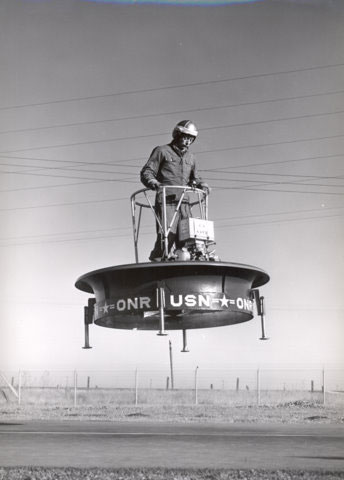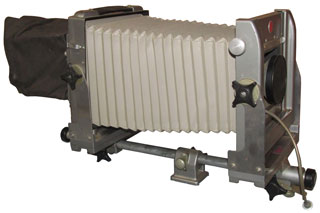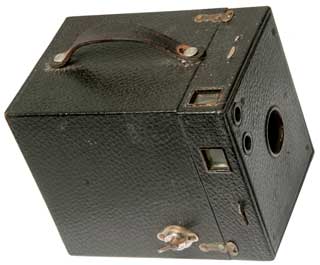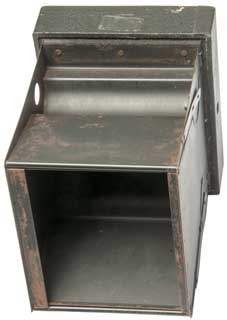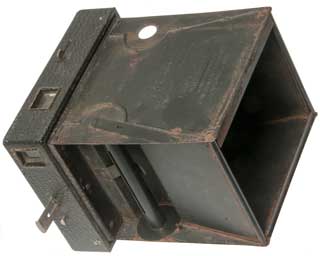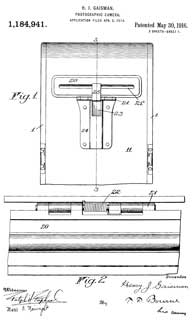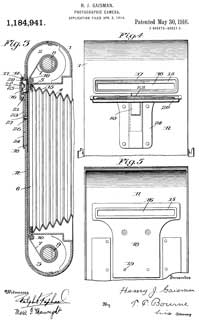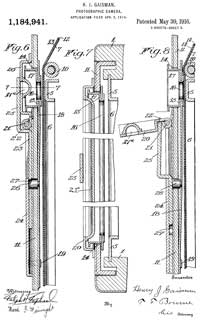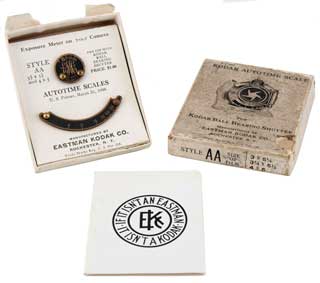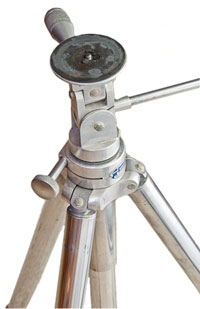Photography
© Brooke Clarke 2000 -2025
New Camera Idea - an eBay Camera
Film Cameras - Nikon
- Hasselblad - View
- Kodak Brownie - Kodak Autographic Folding Camera - Ball Bearing
Shutter
Digital Cameras - DC290
- Digital SLRs have Problems - Single
Lens Electronic View - High Dynamic Range - 2009
Camera
View Camera
Tripod
External Flash
Light Box -
Bounce Flash -
Web Cameras -
CCTV Cameras
IPIX - spherical photograph for web publishing
QTVR - two kinds: 360 degpanoramic
& rotating object
Scanners - Flat Bed - Film -
High Speed Film
Links
Class Assignments
The De Anza Jr college (Cupertino
CA) photography instructor I liked the best was H.W. "Wick"
Wichers. He was a retired professional photographer at
Hiller Helicopters in Palo Alto. Their plant was right next
to the San Francisco bay. He interjected some philosophy
into the class with sayings such as:
- Be careful what you wish for, you may get it - most people
don't really think out all the consequences of their wishes
- Walk, don't run in an emergency - you can not think and run
at the same time and need to think in an emergency
He also had his speed graphic camera set to f/16 at 1/100
second and a flim holder installed. That way he could
take a photo on a momments notice.
(brooke comment: when you have developing tanks for 4x5 film
setup, the time needed to develop a negative is a few minutes,
almost as fast as instant film)
The assignments took the form of
taking a color photo, processing the negative and making a print
mounted on mat board for the class to judge. The idea was
that he would assign a word. When you show the print to
someone the first word out of their mouth should be the assignment
word. Sort of like charades. Some of the words came
from a list in one of the companion volumes of the set of books
called the Great Books (they are too high now to get to without a
ladder). For example "Love".
In one class he pointed out that McDonald's had no advertising and
that they should start (this was about 196?)
Another aspect is you need to know how the photo is going to be
used. For example if it's for a magazine cover it must be a
portrait format photo. For viewing on a computer screen at
full size it should be a landscape photo.
Jan 2011 I've learned from the Hiller Museum that the name of the
De Anza Jr college instructor was: H.W. "Wick" Wichers. But
the phone number has been disconnected.
Film Cameras
My brother, Garry, bought a Nikon F (they didn't number
the first one) and some darkroom equipment. Some time later
he moved away and left the photography equipment. I was
interested in using it so I took all the camera related classes at
the local junior college.
The easiest to use camera was the Nikon F.
It was all mechanical and had no light meter. It has very precise
matching of what you see in the viewfinder and what is on the film
(an early case of WYSIWYG). Later I traded it in on
one (Nikon F
photomic) that had a light meter built into the Pentaprisim
viewfinder that was removable from the top of the camera. It
had a coupling to the lens in front to read the f-stop and a
coupling to the shutter speed dial on the top of the camera.
A needle was visible through the view finder (and from outside)
that moved as the f-stop and/or shutter speed were changed.
This camera was very rugged but it's exposure control was
primitive. This model could take close up photos by use of
extension rings that fit between the camera and the lens.
When this was done the coupling between the light meter and the
lens did not work, but there was a way to manually use the light
meter. There were a number of rings so that the distance
between the camera body and lens could be varied for different
amounts of magnification. This is a feature that I miss with
the N90. Note that the shutter speeds that can be used with
a strobe flash are those slow enough that the focal plane shutter
half's are both open. To use flash at higher shutter speeds
required special FP flash bulbs
that had a long burn time so that as the slit moved across the
film, there would be light from the bulb. There were
different flash sync settings for strobe (instant) and FP bulbs
(delay for bulb to light up).
Around 1994 I got a Nikon
N90, AF
Nikor
35-70mm 2.8 D series zoom lens, MF-26
data
back and a SB-25
Speedlight. This combination has a phenomenal
capability to properly expose scenes with very difficult
lighting (see above). The difficulty is that if you don't
use it often, you forget how to use some of the features (Is it
your memory that goes first?). Nikon has a data
link system Photo
Secretary to allow computer control of the N90.
Liang-Wu Cai - review
of Photo Secretary -
Ken Hancock's - N90
Buddy
1.1 -for Palm Pilot - The MC-31 is available w/out
software. It's Nikon part # 4661.
MC-31.pdf - dwg of a cable that
should work, but where to get the connector? Nikon
F90X/N90s
protocol
-
Cocoon Creations
- cables
to connect Nikon cameras to computers - HarTalk cable
about $116 - software free
For the photos in this page I am using the Nikon N90 and Kodak
Picture Disk. Until I got the DC290 digital camera. Later
replaced by the Nikon N90 then the
D300s.
Nikon Historical Society -
Dr.
Walter Pietsch - major Nikon page
A Pictorial History of Nikon,
Hasselblad & Rollei cameras. - well done Malaysian site
Kodak
DC620 - Nikon F-5 based digital camera
Sigma - Teleconverter
- about $170
Tamron - Teleconverter -
about $130
KENKO AF 2X Teleplus
converter MC7 - This includes the data linkage between camera
and lens. I have one of these.
Nikon - D1 - digital camera has the largest CCD chip size and
therefore the lowest amount of "telephoto" effect on the
lens. Some of the high end digital cameras use a rather
small CCD chip in the camera focal plane and as a result
all lens effective focal lengths are multiplied by some
factor that is greater than 1.
Camera Model Focal Length Multiplier
Kodak DCS
560 1.3 - Cannon based
Kodak DCS
620 1.6 - Nikon based
Nikon D1
1.5 - Nikon's own digital camera
Kodak DCS
315 2.6 - Nikon based
Silicon Film
2.85
*
-
I
have
heard
that this is has been vapor ware for a number of years
Hasselblad
One of the darkroom classes required a minimum format film size of
2 1/4" and I bought a used Hasselblad
500 and a couple of backs and lenses for it. It had a mirror
that moved up when the shutter was released causing the cameras to
jump. I did some tests using a tripod and still the jump
caused blurring of the image. The only way to get sharp
results was to use a tripod and use the manual mirror trip, wait a
few seconds, then release the shutter. I once took a
photograph in a wedding... the minister looked directly at me
because of the loud noise...no more photos with Hasselblad in
quiet locations. The Rolliflex
twin lens reflex is used by wedding and children's photographers
because of it's quietness. Called a Twin Lens Reflex (TLR)
camera where the top lens works through a fixed 45 degree
mirror. They are expensive because two lenses are required.
There are different backs (film holders) that have different
formats. The stock back has a square format. When
this back is used and an 8x10 print is made some of the film is
not used. You know this when you are taking the picture
and there are marks in the viewfinder so you can visualize a
portrait or landscape format and frame accordingly. You do
not need to turn the camera 90 degrees, just look in the
viewfinder. You also can back up or use a shorter focal
length lens and still get the same negative area as a 35 mm
camera then enlarge in the dark room. This gives more
flexibility in framing each shot than with a 35 mm camera where
you need tight framing. Another back has "ideal
format". Instead of getting 12 square format negatives it
provides 16 negatives with the same aspect ratio as an 8x10
print. This is great for landscape type shots, but rather
awkward for portrait shots. The third back I had was the
"S" back. It provided 16 square negatives that were the
correct size for mounting in "Super" size slides that had the
same outside dimensions as a standard 35 mm slide, but much more
view-able area. You also could use transparency film with
the stock back and get 2 1/4 square slides. When mounted
in glass slide holders (to keep them from buckling) and
projected on the Rolli slide projector these were
stunning. The sharpness and size are unmatched.
The great feature of the Hasselblad is the Exposure Value (EV)
setting on the Carl
Zeiss lens. Two rings set the f-stop and leaf
shutter speed and lock to each other. When both of them
are turned the f-stop AND shutter speed both change, keeping the
EV at the same value. When a flash is used the EV can be
set for the background lighting and the f-stop set for either
fill or full flash exposure. Since the shutter is a leaf
type the opening is always usable for flash, whereas a focal
plane shutter like in most 35 mm cameras can only be used with
electronic flash at a few speeds.
Hasselblad USA - Digital
Backs - List
of brands with $ -
Digital Backs: Dicomed -
MegaVision - Phase One - Kodak
DCS 465 - Scanview
- LeafDCB II Live
-
Dicomed Patent US5570146:
Digital image recording device
A Pictorial History of Nikon, Hasselblad
& Rollei
cameras. - well done Malaysian site
Calumet 4x5 View
Camera
The other camera my brother left was a 4x5 view camera and the
accessories that went with it.
The camera had a case that also held a number of film holders,
I used a black cloth rather than the hood shown on this one, and
other accessories like the SEI Photometer
(spot light meter).
Once the darkroom tanks are set up (with floating lids) it is
quite easy to develop 4x5 B&W negatives. As a final
project in the Zone System class, I took a single exposure of an
outdoor landscape scene, developed the negative, and made a single
print that was turned for an "A" grade. The Zone System is a
great way to visualize and expose. The view camera allows
correcting the perspective of the scene as well as the advantages
of the larger film size. (PS there's a crop tool in Adobe
Photoshop that allows some perspective correction.)
The Zone System Manual by Minor White was the book used in the
zone system class. There is anew
version of the Zone System manual coming soon.
The basis for the Zone System was work done by Ansel
Adams.
YouTube: HIDDEN
VISION: The MYSTICAL Photography of Minor White, 10:25 -
A Calumet 4x5 view camera was used for some time. It was a
very low cost view (also called Plate) camera. The foot
where it attaches to a tripod has a notch, not sure why, but it
limited the contact area to my Tiltall tripod. So I got a
second Tiltall tripod, removed the circular top plate and machined
the left and right sides off so that the remaining plate was the
correct width to fit the notch in the camera base. This
tripod still would work for 35 mm cameras.
With a darkroom equipped with 4x5 developing tanks filled with the
needed chemicals and covered with floating lids it's almost as
fast as Polaroid to develop a negative. The two big
advantages of a view camera are the large negative size and the
ability to use the motions of the lens frame and film frame to
control perspective and/or depth of focus.
Linhof makes view cameras that
were exquisite, but way out of my price range.
Kodak Brownie (Wiki)
Over a million of these cameras were made. This particular
model, the No.3 Model B was made in Canada between 1911 and 1917
(See Brownie-Camera
No. 3). This camera has the film tension spring on the
film, not the spool.
f/stops: 0.388", 0.281", 0.16"
Shutter speed: Time or ??? fixed speed shutter (guess
Kodak No. 124 Film gives 3-1/4" x 4-1/4" image. This allowed
making contact prints instead of getting small economical prints
to expensive enlarged prints that might be fuzzy.
Operation
To open case undo the two latches and while turning film
advance CCW (same as arrow) pull is out about 1/4". Now
the back can be pulled out of the case.
Brownie Photos
References:
Camera of the Month:
Brownie
Brownie-Camera - Roll Films
-
BBC:The most
important cardboard box ever?
Kodak Autographic Junior
Folding Camera
"Autographic" means that you can annotate the film with
things like the date, place, names, &Etc. To do this
there is a stylus cliped on the back of the camera right next
to the trap door that allows access to the paper backing on
the film. It is not a model of camera.
Autographic camera models:
Junior: 1, 1A, 2C & 3A
Vest Pocket
Brownie
There are some cameras on eBay that use the word
"autographic" in the title but there's no stylus or trap door,
so it's being misapplies in those cases.
The Kodak Vest Pocket Hawk-eye is not an autographic
camera. It lists patents:
1107358
Photographic camera, John A Robertson, Robert Kroedel, Kodak,
1914-08-18 - folding camera bellows support
1112525
Tripod-socket for camera-beds, Harry R Darling, Kodak,
1914-10-06, - has the feel of a PEM nut.
1169882
Film-winding key for photographic cameras, Charles F Speidel,
Kodak, 1916-02-01
1211683
Folding camera, Harry R Darling, Kodak, 1917-01-09, - door
latch & foot
1218135
Photographic camera, Ernest E Underwood, Frank H Reynolds,
Kodak, 1917-03-06 - easier to make
1610153
Roll-film camera, Frank H Reynolds, Kodak, 1926-12-07, -
exposure frame does not contact film except at the edges, i.e.
no scratches.
1610175
View finder for photographic cameras, Charles F Speidel,
Kodak, 1926-12-07 - can be turned for portrait or landscape
1672841
Photographic-camera-spool holder, Ernest E Underwood, Kodak,
1928-06-05
Pat No.
|
Title
|
Inventor
|
Date
|
691592
|
Photographic camera
|
Frank
A Brownell
|
Jan 21, 1902
|
|
|
|
Apr 29, 1902
|
917078
917079
|
Photographic-film-developing apparatus
Focusing device for cameras
|
Robert
Kroedel
|
Apr 6, 1909
|
933470
933713
|
Camera-back (folding)
Focusing device
|
Robert Kroedel
|
Sept 7, 1909
|
937077
937156
937248
|
Focusing device
Focusing device
Photographic shutter
|
Robert Kroedel |
Oct 19, 1909
|
|
|
|
July 8, 1913
|
|
|
|
May 19, 1914
|
| 1144140 |
Photographic-camera back (folding)
|
Robert
Kroedel, Charles
F Speidel
|
Oct 16, 1914
|
1144074
|
View-finder (for folding camera)
|
Charles
F Speidel
|
June 22, 1915
|
|
|
|
Dec 28, 19??
|
1169882
|
Film-winding key for photographic cameras
(120 roll film?)
|
Charles
F Speidel |
Feb 1, 1916
|
|
|
|
May 30, 1916
|
|
|
|
Aug 22, 1916
|
|
|
|
Nov 21, 1916
|
Autographic Brownie No. 1-A, No. 2, No. 2-A, No. 2-C, No. 3-A
"Autotime" is an interchangeable dial for both the small
shutter (above the lens) and the f-stop (below the lens) to
accommodate different film speeds and be non technical.
But as film speed and light metering became more standardized
these got standardized on actual shutter speed and f-stop
instead of using words like "outdoor portrait" and "bright
clouds".
Vest Pocket Autographic Kodak
There is a stylus clipped on the back.
Brownie Patents
?
|
|
|
526445
Folding Roll Holding Camera, D.H. Houston, (not assigned),
Sept 25, 1894, 396/344 235/91C
396/538 -
526446
Roll Holding Photographic Camera, D.H.
Houston, (not assigned), Sept 25, 1894, 396/150 396/349 396/511 281/7 -
526471
Camera Shutter, G.A. Waters, (not assigned), Sept 25,
1894, 396/495
- air bulb type
|

|
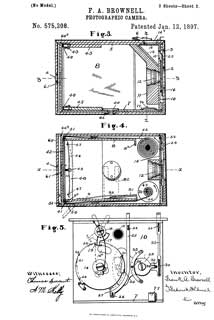 |
 |
575208
Photographic Camera, F.A. Brownell, Eastman Kodak Co, Jan
12, 1897, 396/446; 396/511 - Early version of
the Brownie
|

|
|
|
622955
Photographic shutter, F.H. Kelley, Eastman Kodak Co, Apr
11,1899, 396/496 -
|

|
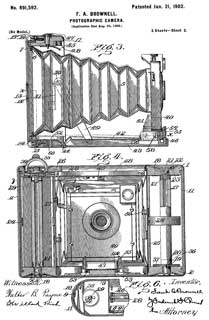 |
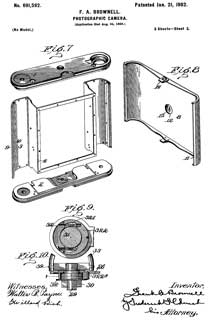 |
691592
Photographic Camera, F.A. Brownell, Eastman Kodak Co, Jan
21, 1902, 396/345; 396/538 - |
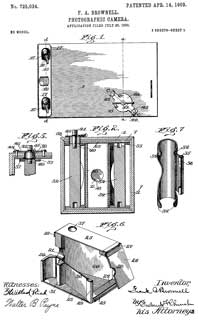
|
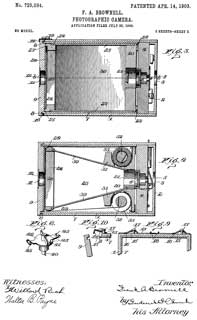 |
|
725034
Photographic Camera, F.A. Brownell, Eastman Kodak Co, Apr
14, 1903, 396/387; 396/535 - improved
version of Brownie camera
No. 2 Model D: |
|
|
|
No. 2 Model D: Sept. 7, 1909 |
|
|
|
1112525
Tripod Socket for Camera Beds, H.R. Darling, Eastman Kodak
Co, Oct 6, 1914, 248/187.1;
403/193; 403/199; 411/181; 29/522.1; 403/194; 403/282;
411/968; 29/512; 29/432 -
|
|
|
|
No. 2 Model D: Feb. 1. 1916, |
|
|
|
1176329
Photographic shutter, Ernest E
Underwood, Eastman Kodak Co
, Mar. 21, 1916, 396/502;
396/459 - No. 2 Model D: |
Ball Bearing Shutter
The opening title sequence for the TV series Vienna Blood (Wiki)
shows this at the bottom of a spiraling staircase. It
took a number of views to catch "Ball Bearing Shutter" at the
top of the lens. In a similar manner I found hardware
items in the TV series Murdoch Mysteries (Wiki,
Oliver
Typewriter, Fountain Pen).
Kodak shutter patents by Paul J Marks - they all have the same
look and feel
885142
Photographic Camera Shutter, Frank A Brownell, Eastman
Kodak, 1908-04-21, - not Ball bearing, "25-B-T-50" arc,
not circle
946679
Photographic shutter, Paul
J Marks, Eastman
Kodak, 1910-01-18, - "Ball Bearing Patent" &
"Autotime" patent
1049379
Photographic shutter, Paul
J Marks, Eastman
Kodak, 1913-01-07, -
1239025
Photographic shutter, Paul
J Marks, Eastman
Kodak, 1917-09-04, -
1240073
Controlling mechanism for photographic shutters, Paul
J Marks, Eastman
Kodak, 1917-09-11,-
1270311
Photographic shutter, Paul
J Marks, Eastman
Kodak, 1918-06-25, -
1422460
Photographic shutter, Paul
J Marks, Eastman
Kodak, 1922-07-11, -
1422461 Iris diaphragm, Paul
J Marks, Eastman
Kodak, 1922-07-11, -
1483465
Photographic shutter, Paul
J Marks, Eastman
Kodak, 1924-02-12, -
References:
Camera Wiki: Ball
Bearing Shutter -
Through a Vintage Lens - Leaf
Shutters - many details & videos
Vintage Photo.NL - Kodak 3A Folding Pocket: a silent movie from
1910 -
Other early Kodak patents
408596
Camera, G. Eastman, 1889-08-06, 396/462; 396/494 -
442216 Photographic
Camera, F.A. Brownell, December 9, 1890 396/345
486397
Camera Shutter, G. Eastman, Nov 15, 1892, 396/494
501866
Photographic Shutter, F.A. Brownell, July 18, 1893, 396/493 -
579949
Roll Holding Camera, F.A. Brownell, Apr 6, 1897, 396/385; 396/511;
396/535 -
661469
Roll Holding Camera, G. Eastman, Nov 6, 1896, 396/411; 396/535 -
661504
Photographic film cartridge, M.J. Ehlman, Nov 13, 1900, 430/501; 242/587.2
- roll film paper leader & trailer, but not next to film
711617
Photographic Film Spool, J.T. Clarke, Oct 21, 1902, 242/611.2; D14/484 -
742964
Spool, F.A. Brownell, Nov 3, 1903, 242/118.61; 242/118.7 -
778403
Photographic Film Cartridge, W.B. Cline, Dec 27, 1904, 430/501 -continuous
paper + film in middle
807458
Photographic Film Cartridge, H. Le B. Gray, Dec 19, 1905,Harry
Le B Gray, Eastman Kodak Co
1481272
Exposure-identification camera, John
A Robertson, Philip
W Tierney, Kodak,
1924-01-22, - a wheel with characters A to Z and 1 to 0 allows
marking film with things like a date, name &Etc. - shown on a
folding camera.
Henry J. Gaisman
Digital Cameras
There is a tendency for manufacturers to tout the number
of pixels. This is the total number and since a color camera
uses at least 1 red, 1 green and 1 blue pixel to form the image
the actual count is at least 3 times smaller than stated.
For publishing to the web I have my DC-290 set for the lowest
resolution possible and the quality is great.
14 May 2007 - This was a mistake. I've since learned to take
all photos with the highest resolution tiff file format (about 6
MB per photo). In the computer you can now crop, rotate,
erase background and still have a very good image. Then for
the web page the image can be resampled and shrunk down to a
smaller file size for the thumbnail version, and the hi resolution
version is just a click away.
It's often that case that I take a hi res photo and later when
working with the image in the computer see things that I had not
noticed with my bare eyes. In effect the resolution is so
high you are seeing a macroscopic if not microscopic view.
For example you can read the fine print on top of integrated
circuits that you can not read with just eyes.
The optical range finder changes with the optical zoom, but does
not change when an accessory lens is installed or the digital zoom
is activated. But by using the LCD it's close to what you
see is what you get.
The automatic focus mechanism is offset from the lens so when
taking photos of subjects that are say a foot away from the camera
and at an angle, like something on a table top, the range finder
is typically looking a few inches further than the subject.
A fix is to place an object in the scene just to the right of the
subject that will be cropped out later. You can move the
focusing target back and forth and press the shutter 1/2 half way
to force a new focus cycle and by watching the LCD (or better the
TV output) find the correct focus target location.
I was once very interested in getting a digital camera
as a replacement for my film camera. Recently I saw some
photos taken with the Epson digital camera. I noticed that
the exposure was what you would expect from a simple (throwaway)
35 mm camera with a built in flash. This is a far cry from
what you would get form the Nikon N90. The N90 has 2
microconlrollers in the body, 1 in the lens and 1 in the flash (4
total) that are talking to each other and can set the flash and
ambient light settings far better than most humans (including
myself). Digital cameras IMHO have their place, but it is
not as a substitute for a good film camera. Places where
they would be good are similar to where you would use a Polaroid
film camera (instant viewing of image) or throwaway type camera
(snapshots). [2022 - The Nikon D300s is probably better than
a film camera.]
10 Jan. 1999 - The Canon Pro70 ($1200)
and Olympus D-620L ($940)
look very similar in appearance and may be the start of full
featured digital cameras. The Pro70 has a huge advantage
if low light levels are important to you.
Leica has the S1
series of studio cameras with resolutions up to
4,000x4,000. They have adapters for most high end camera
lenses like Nikon or Hasselblad. About 75 second exposure times.
Cannon Computer Systems
- Cannon USA -Digital
Cams - Cannon
Power Shot -PowerShot
Pro70: 1536x1024 pixel, design elements of Canon's
top-selling EOS, EV2 ! - road
test - (<$ 1,500) - Cannon
EOS DCS 3 - EOS with Kodak digital add on - DCS
1 - 6M pixel - EOS D2000
($12,950)-
2M pixel -
CMOS PRO -
Affordable Digital Studio Camera (must be tripod mounted)
digital camera
related internet resources - most in Japanese - includes
Consumer, Pro and Tethered (studio only) digital cameras
Internet Product
Watch - Digital
Cameras -
Imaging
Resource - Choosing
a Camera, by Barbara Coultry
Digital
imaging
has
arrived
at
Wall
St.
Camera - OlympusD-500L
& D-600L
- (new D-620L)
-
Digital Camera Resource
page -
Plug-In Systems -Digital
Camera
Guide - Consumer
(<$1500) - Professional
(>$2000)-
Large/Teathered (very expensive)
Steve's Digicams -
NIKON
Breaks The Two-Megapixel Barrier - GPS input that allows
photographers to geographically tag shot locations - Coolpix 950
($972)&
700 ($585)
D1
has the look and feel of a 35mm film camera, D-type AF Nikkor
lens
DCR-TRV900
- low resolution has quite a following for still
work although it is also a video recorder.
Kodak
Digital Cameras- DC265
available in bundle with Garmin III+ GPS receiver and a custom
script in the camera to add coordinates to images
stock
DC265 $999 @ CDW - DC290 (<$700 10May00) & Tiffen
lens adapter + 37mm lens + filters
Silicon Mountain Design - high
speed CCD cameras
HyperZine Communications - Hot News Digital
Imaging -
Digita Camera -
Scripts for use with DC290 and others, including adding GPS Lat
& Lon, compass direction -
Flash Point
Technology makes the Digita operating system used the in
the DC290 &other cameras and supports scripting and now FX
in the camera. Digita Application
developer -
Kodak DC 290
I ended up getting one of these and a bunch of accessories.
It turns out that I have it set for the lowest possible resolution
for web publishing. Typical file sizes are under 100 K
Bytes. In this mode the Compact Flash card holds over 150
images. It has a motorized optical zoom feature that's very
handy. There is also a digital zoom that I haven't used.
The DC290 has 4 resolution settings and 4 quality settings.
File sizes are in Kilo Bytes.
The number in ( bits/Pixel).
|
Resolution
|
Resolution
|
Print Res
300 DPI
|
File Size
Quality
= TIFF
|
File Size
Quality =
Best.jpg
|
File Size
Quality =
Better.jpg
|
File Size
Quality =
Good.jpg
|
|
Ultra
|
2240 x 1500
|
5 x 7
|
not allowed
|
1058
(2.5)
|
732
(1.7)
|
498
(1.1)
|
|
High
|
1792 x 1200
|
4 x 6
|
6337
(24)
|
799
(2.9)
|
501
(1.8)
|
341
(1.3)
|
|
Medium
|
1440 x 960
|
3 x 5
|
4087
(24)
|
549
(3.1)
|
403
(2.3)
|
235
(1.3)
|
|
Standard
|
720 x 480
|
1.6 x 2.4
|
1048
(24)
|
229
(5.3)
|
175
(4.0)
|
113
(2.6)
|
If any photo post processing is to be done, it's best to use
the TIFF Quality so the camera does not compress the image.
For web photos Standard resolution is more than enough for all
but full screen shots. So I'm going to start using
Standard - TIFF format. This is only 1 photo per floppy
disk.
Note that you can estimate the number of shots per flash memory
card in the camera by dividing the card size (20,000 KB
standard) by the file size. So for Standard-TIFF
20,000/1048 = 19, but my camera only allows 16 because there is
some other stuff stored on the flash card.
Steves Digicams - DC290 review
- 1999 - note the camera's firmware can be updated and features
added via the USB connection.
One report on the Kodak DC290 points out that the exposure time
can be up to 1/2 second and so a tripod is needed for low light
photo. I have seen "fuzzy" photos with the DC290 that were
taken in low light conditions, now I will use a tripod.
Picked up this Arri tripod on eBay.
Manual Override
The DC-290 allows you to manually adjust the exposure and that's a
vital thing when trying to take product photos. See my eBay camera web page for why this is so
important. "Manual Override" are key words to look for.
Digital SLRs have Problems - 13 Oct 2007
Digital SLR cameras are
flawed. A film Single Lens Reflex camera has a huge
advantage over other film types in that you're viewing directly
through the taking lens allowing precision focusing and framing of
the shot (well at least on good SLRs like Nikon, etc.). This
is not the case for range finder or Twin Lens Reflex
cameras. This gets to be more important when doing close up
work. A disadvantage of the SLR is there's mirror
flop. On 35 mm cameras it's barley tolerable and on larger
cameras like Hasselblad you can't take a focused picture if you
just push the shutter because the mirror flop is so severe!
You MUST use the mirror release, wait a second or two, THEN
release the shutter. When a Digital SLR is attached to
a high power telescope or telephoto lens the mirror flop gets to
be a bigger problem.
The digital SLRs retained the mirror flop problem but eliminated
the key idea of viewing the actual image.
Digital Single Lens Electronic View aka
Digital SLeV
The Digital SLeV would have an outward appearance similar to the
Digital SLR, but would work differently in terms of the viewfinder
operation.
Eliminate the SLR mirror and operate the CCD chip with a video
output feeding a small LCD color monitor. The image you now
see is exactly what will be recorded digitaly, although a lower
resolution version. This has a big advantage when outdoors
in bright light where the camera back LCDs are washed out.
Note the DC290 has a television monitor output. This
same circuitry could feed the small color LCD that you would see
in the viewfinder. Since it's digital there also could be a
digital zoom to make focusing easier. So there's no new
technical innovation needed.
Note that the proposed SLeV camera can be made to use the same
lens interface as was used on film cameras so the lens from a film
camera would also work on the SLeV. The iris control would be
different than on a film camera. In a film camera the iris
is wide open when not taking a photo and stops down after the
shutter is pressed and just prior to the exposure then it
opens. But for the SLeV camera the iris would always be at
the exposure stop. This is not problem since film cameras
have a depth of field preview button that stops down the iris
manually. That mechanical function would be reversed, i.e.
in the SLeV camera the default is iris stopped to exposure setting
and when button pressed it's opened wide. The reason for
this is that in you need the CCD seeing the same light level as
for the actual exposure.
If the exposure time is for example 1 second then the update rate
for the viewfinder image will be one second. This means that
you can frame a shoot a photo where you can NOT see the scene with
bare eyes!
Advantages
- The displayed image framing is exactly the framing of the
digital image since it's coming from the same chip.
- The image from the chip includes all the wavelengths of
light so near IR images will be shown but which are now
invisible to the human eye.
- You can now focus optical systems that are attached to the
camera with much more precision.
- Can frame and focus images that are impossible to see with
bare eyes either because of near IR light or very dim light.
Sep 2008 - Panasonic has announced the G1 but it's not yet on the
market.
"It lets you see in the LCD how adjusting the exposure, white
balance, aperture and even the shutter speed will affect the
photo. "
http://www.dpreview.com/news/0809/08091202panasonic_DMC_G1.asp
http://www.dpreview.com/Previews/PanasonicG1/
http://www2.panasonic.com/consumer-electronics/shop/Cameras-Camcorders/Digital-Cameras/Lumix-Digital-Cameras/model.DMC-G1K_11002_7000000000000005702
The problem is that the lens standard "Micro 4/3 System" is
new so there are not any accessory lens available only an adapter
to allow using "4/3 System" lens.
2009 Camera
In order to capture
High Dynamic Range images inside the
camera I'd like to get one of the Nikons that have this feature.
Nikon digital SLR(D series) cameras in high end first order:
These all use interchangeable lens
D3X
D3
D700
D300 - $2500 - borrowed from a friend and like it very much
- but difficult to use (maybe that's the price you pay for the
power)
D90 -
D5000 -$850 - (Intro: 14 Apr 2009) (Costco kit: D5000, 18 - 55 mm
+ 55 -200 mm $1,000 Aug2009)
D80
D60 (Costco kit: D60, 18 - 55 mm + 55 -200 mm $700 Aug2009)
D40
Nikon Compact digital SLR (P series) cameras high end first:
These have a fixed lens
P90 - $400 24X 26-624mm
P6000 - $500
P80 - $350
P60 - $230
2022 - It turns out that the D300s has an optional RAW image
setting of 14 bits per color channel that gives you
fantastic
dynamic range with a single exposure.
Tripod
|
|
The Tiltall tripod has all
Aluminum construction and much more sturdy than the commonly
available consumer type camera tripods.
The tips of the legs have rubber hemispheres so they can
be used indoors on smooth floors without scratching the
floor (like the Arri Tripod does). And by
turning the knurled ring a point will protrude from the
tip of the leg which is good for some surfaces to better
hold the legs in place.
A Quick release adapter would easily fit the head.
Tiltall
Tripod Support - there is a loyal following of these
tripods and spare parts are still available. |
 |
A feature I really liked was
the ability to unscrew the knurled ring on the bottom of the
vertical column and pull the column completely out of the
tripod, then turn it upside down and reinsert it into the
tripod from the bottom. Now you can attach a 33 mm SLR
camera and position it very close to the ground which
is ideal for macro photography.
|
External Flash
Jan 2008 - Wanted flat lighting and
started with a simple light box. Since I already have a
flash for the N90 film camera that's what I'm using.
But needed to get some bits and pieces to hook it up to the Kodak
DC290.

The key part is
the Monfrotto Avenger Super Clamp C157B. This is a joy to
use. Not only does it work well but you know it works
well by how it feels. And the price ($25 - 2008) is very
reasonable. You can buy a similar function for 1/10
the price but you'll also be buying gray hair and worry. In
addition a Dot Line 15 foot Male to Male PC cable.
The Super Clamp can accept a large numer of attachments that all
have stud with a hex head in the center. In order to remove
the stud the small knob on the front needs to be backed out a few
turns AND the chrome button (in photo at left) pushed while you
lift out the stud. In this case the suud is called the
Reversible Stud 2907 and has English tripod threads on one and and
European tripod threads on the other.
The stud holds a Smith VIctor Shoe Mount. It's the silver
block under the Nikon SB-25 strobe.
The problems I've had with this setup are:
- The flash does not fire, the reasons have been:
- unkonown
- cable unpluged, that why the circling of the
cable and a simple knot. No problem since.
- the batteries were dead.
- the cable is a small hassle. A wireless (IR
or radio) trigger would be nicer.
- the batteries are a hassle. I'm thinking
about making a battery adapter so a simple 6 volt
power supply can be used. Also that allows for
remote on and off.
- when the strobe is handled, like taking it off the
shlef to turn on or off, the strobe fires, wasting
battery power.
Light Box
25 Jan 2008 - Starting to get the parts required to use the Nikon
SB-25 flash that has been sitting idle since I'm not doing much
with the Nikon N90 film camera with my second Kodak DC290
digital camera (got the second DC290 outfit from eBay for
$60). Space is at a premium so the plan is to use a
Manfrotto C1575B Avenger Super Clamp on the shelf that's just in
front of my right hand as I sit here at the computer. Then a
Manfrotto 2907 Reversible Stud plugged into the 5/8" (16 mm)
spigot on the clamp to provide a male 1/4-20 thread. Then a
Smith Victor Shoe Mount which will hold the SB-25 strobe
flash. A Dot Line DL-0430 Male-Male PC cord connects the
camera and strobe.
I've done some simple experiments by using four sheets of paper
taken from the laser printer and arranged with one on the desk
top, two in a U shape being held in place with boxes and one sheet
sitting on the top. When a product is photographed using the
on camera flash the light is much more even and the reflections
are controlled much better than when just placing the product on
the desk top.
By using a used USPS box marked O-BOX#4 that's about 7" x 7" x 6
1/4" an cuting out three sides, leaving about 1/4" and on the
inside gluing printer paper a simple light box was made.
It's used with the open top facing horizontally and with a Nikon
SB-25 strobe a few feet away aimed at one of the papered
sides. See the
May Baby
Torch for an example.
When working with the light box the strobe gets clamped to a
bookcase shelf that's right behind where I sit and it's upside
down and angled so it points down and at the box.
Light Box
The main reason to use a light box is to control
reflections. For example shiny or mirror surfaces,
like on plated metal.
|
Bounce Flash
The light box will also provide very even illumination and pretty
much from all sides, i.e. flat lighting. But if you only
need flat lighting and not reflection control, like an subject
that's not shiny, then bounce flash is the way to go. Simply
aim the flash at the ceiling (assuming it's close to white).
The problem is that it takes much more flash power than a light
box where the flash is a few feet from the subject. For
ceiling bounce the distance is more like 8 feet. The big
advantage is you don't have the box size limit. For example
see
PSG-9
Fig 9 where there was virtually no retouching.
Bounce Flash
Provides flat lighting.
|
For bounce flash the strobe is mounted like in the photo above
pointing up at the ceiling and about three feet below.
Web Cameras
KPIX TV San
Francisco -
WEBLAB TV Page
- Map of the World link to cam
Web Cam's From Around
The World -
Web Cams -
huge number of links -
Guide to
Creating Real Audio & Video -RealSystemô
G2 Production Guide -
CCTV Cameras
This is a way to use a digital camera fitted with a 180+
degree lens to take a spherical photograph. The Ipix company
has software that mates the two images and allows publishing them
on the web. They support the Kodak DC200,
Nikon Coolpix
900, Olympus D-340L
and Pentax PZ-70 cameras.
There are two flavors of Quick Time VR, one is an
outward looking panaroma (similar to IPIX, but with no up-down
panning). The other is a rotating object, but with no up
down panning.
Quick Time Virtual Reality is used for the Harley
Davidson Engine Demo. The IPIX system is what I
would call a looking outward system with your eye in a fixed
location and you choose where you look. The QTVR system is
looking inward. The object is on a turn table that can be
turned by the observers mouse. There may be a way to zoom
in and out, but so far I have not been able to get it to work.
Apple Computer - QuickTime VR -
QuickTime
Virtual
Reality
for Educators and Just Plain Folks -
TourVision's
QTVR
Links - examples of QTVR
Manfrotto
- heads
for panoramic picture taking -
Peace River Studios
- pan heads & object rotators
Brian Lawlar's pages -
info on home built panaromo adapter & details - QTVR -
Scanners
Scanners used to come in three flavors: hand scanners,
flatbed and film. The hand scanner was priced in the low
hundreds but could only scan about a 4" width and needed software
to splice the two images used to scan an 8.5" wide page.
These have gone away because flatbed scanners are now in the same
and lower price range. A flatbed scanner is very much like a
copy machine can can scan a book or even some three dimensional
objects. The film scanners come with the ability to scan
various sizes of film with 35 mm being the narrowest, then 70 mm
and 120 roll film, then 4"x5" sheet film. Conventional 35 mm
film is returned in strips of about 5 exposures rather than as one
roll whereas 35 mm APS film is returned in it's cassette.
Most film scanners have an adapter so that they can work with APS
cassettes.
These are scientific tests of the quality of the scanned
images. Done for astronomy reasons, but the results are good
for everybody.
Flat Bed
After looking into scanners I found the HP ScanJet 6200xxx where
the xxx suffix specifies the software package that comes with the
scanner. This is an 8.5" x 11.7" flat bed scanner with 36
bit digitizing. It has 1200 x 1200 dpi direct resolution and
up to 1E6 x 1E6 enhanced resolution. They also have a 35mm
slide adapter, but no provision for scanning 35mm negatives.
This should just be a software color reversal.
The advantage of a flat bed scanner is that it can do both
photographs and can be used to scan documents like books or 3
dimensional objects that will not fit into my fax
machine.
The scanner does a great job on objects that have a depth of less
than 1 inch. Much better than a camera.
US5483053:
Variable resolution color image scanner having an exposure delay
between successive linear photosensors detecting different
colors - by slowing down the movement of the scanning mechanism
and sampling much more frequently than a native pixel they can
resolve features in the scan direction smaller than the native
pixel size hence get very high resolution in the scan direction.
US5726771:
System and method for optimizing tonal resolution in an optical
scanner - the prescan is used to optimize the A/D converter
dynamic range
US5523562:
Optical scanner having enhanced depth of illumination - they are
paying attention to depth of field
US5463217:
Adapter for scanning transparencies with a reflective document
scanner - this is the adapter included with the 6200Cxi
For 80 patents use the IBM Boolean search
page with assignee = Hewlett-Packard (must use the hyphen)
and Abstract = scanner
Jan. 17, 1999 - I got the HP
6200Cse from my local Staples office
supply store. It came with the 35mm slide adapter (have
not unwrapped it yet) and OCR software. On my cars page I have a photograph that I scanned (the
only way because the photo has an autograph on it that is not on
the negative). On my electronics
page I have a technical manual
where it was not possible to get good legability of both all the
text and the B&W figures. Using grey scale instead of
B&W was better, but using the OCR software to convert the
words into text then scanning just the figures worked even
better and reduced the file size considerably. The raw scanned
image of the page was 1.7 MB and no matter what file format I
used it was very difficult to both see the fugures and read the
text. The HTML version is about 4 kB for the text and less
then 30 kB for both figures. Here is a portrait of George as a JPEG file (11 k). George.BMP (198 k about a
minute to download - then view locally) Jackson.jpeg (832K)
When scanning material that is printed on both sides it would be
good to have a flat black background (the scanner lid is
white. To improve the bleed through, like to see
watermarks and bands, it would be good to have a mirror as a
backing.
Sep. 19, 1999 - The scanner does a fantastic job of
imaging printed circuit boards with the components installed! Hobo1.jpg - Hobo2.jpg -
See Don Lancaster's web page about using scanners in place of
high resolution cameras for instrument front panel images. webimage.pdf, imagimag.pdf
-
One thing that I like about the scanner is that the images are
the right way around. The Kodak picture disk always seems
to have the images upside down or some other wrong
rotation. This is to be expected since they don't know how
I was holding the camera. With the scanner I place the
source image correctly so the step of rotating the image is not
required, saving some time. Since you can scan a 35 mm
slide it seems that you should be able to scan a 35 mm
negative. Then the software would need to reverse the
colors and add the standard cyan & yellow color packs plus
allow adjusting the color balance to yield a positive.
Adobe Photoshop has a menu choice that reverses the negative
into a positive. To use this you need to use the slide
scanner but with a 35 mm negative in it. Maybe adding a
glass plate to keep the film flat would be a good addition.
When scanning double sided material like newspapers it is good
to have a black piece of paper or flat sheet of glass to hold
down the material so that the printing on the back side will not
be seen through the material.
Jan 17 2001 I had a lot of trouble with a "scanner
not found" error and not being able to use the scanner without a
lot of work removing and reinstalling the software (nothing
wrong with the scanner). I think this was casued by my
upgrade to WIN98SE. Because of a computer crash I am now
back to WIN98 and will NOT upgrade to WIN98SE. With
WIN98SE if you install any other USB device or defragment your
hard drive the scanner software will die. The fix is to
compleatly remove the software, unplug the scanner and
disconnect it from the computer. It's a good idea to copy
the HPPSPRO folder form the CD-ROM onto your desktop (and leave
it there), then in safe mode do the install from the
folder. After restarting the computer power up the scanner
and then connect the USB cable and the computer will
recogniae the scanner and configure it. If you send email
to sj6000_support@am.exch.hp.com
a computer will read your email and respond with the latest work
around.
The glass gets plastic outgassing residue that makes a white
film on the inside near the lamp (top) end. You can see
this if you start up the scanner at night and after the lamp
parks you will see the film. Just remove top cover (lift
it up) and the four screws that hold the glass (two are under
caps at the bottom end) and clean the glass. This improves
the shadow detail on some objects.
I now think of the scanner as a specialized camera for small
objects and use it for many images on my web pages.
Seperate Web Page for HP Scanjet 6200C Problems.
8 April 2001 - Finally the
problem may be solved. The software drivers for the Kodak
DC290 and the HP ScanJet 6200 are not compatible. The
scanner is now working. I plan to:
- run msconfig and in startup, disable all the (3 or 4?) items
relating to the HP scanner.
- reboot the computer
- install the DC290 software
- use the DC290 osftware
- run msconfig and in startup, disable the DC290 item &
enable the HP items
- reboot and use the scanner
14 May 2007 - after getting a new WIN XP computer these problems
went away. I have both the DC290 and HP 6200 connected with
no problems. All the problems were Microsoft's poor USB code
in WIN98 & WIN98SE. Prior to getting the WIN XP computer
I gave up on the 6200 and HP offered a upgrade to the 8400 scanner
at a fair price and I accepted. After receiving the 8400 and
trying it I very quickly called HP back and made arrangements to
return and 8400 and get a refurbished 6200. It seems the
8400 is designed for computer newbies, sort of a point and shoot
version of a scanner, and can NOT be controlled by the
histogram. The user interface was a series of windows which
you needed to navigate through for every scan, what a poor design.
Notes
on scanning 35mm slides - HP patent 5,463,217 is referenced
above
HP
PhotoSmart S20 - optical scanning resolution of 2400 dpi
for film strips and slides, 300 dpi for photographs (to 5x7),
and 36-bit color depth $500 list price
Film
An advantage to film scanners is that they are scanning the
negative or positive directly. If a flatbed scanner is used
on a print, then it is one generation away from the source and
will have reduced quality. This is similar to copies of an
analog audio tape, each generation adds noise and is of lower
quality. Note that the rules change with the introduction of
the HP 62xx series of scanners. They have resolutions that
are extremely high and can scan a negative with more than enough
points.
Film Scanning Services
Kodak and I expect other photo processors will return not only
your developed film and prints, but also some form of digitized
images. The Kodak Picture Disk is an economical way to get
digitized images from film if your needs are relativity small.
Review
of Film Scanners - Kodak Q60 Test Negative ordering
information is available from Kodak. At the FTP site click
on Orderinfo.pdf. For more information about the Q60 go to
the Kodak Home page and
Find "Q60". & how
to
evaluate results
APML
Film Scanner Comparisons -
Kodal RFS Professional 2035,
3570
and 4050
Rapid Film Scanners
The 2035 does 35mm slides and negatives at 2,000 by 3,000
resolution (6,000,000 total)
The 3570 does 35mm to 70 mm film at 2,000 by 3,000 resolution (up
to 18 MB total)
The 4050 does 35mm to 4x5" up to 4096 x 6144 resolution (72 MB
total)
Dimage is 8,000,000 pixels per image - $527
@
netsales
QuickScan is 1,000 by 1,000 pixels per image (1,000,000 total
pixels per image). - $795
@
netsales
{ older models=Coolscan 2000 - Coolscan LS-1000 - Coolscan
LS-20 @Publishing
Perfection}
The other option is a film scanner. The Nikon Coolscan
series scanners are designed to scan negative and positive,
monochrome or color35mm film. The LS-30 is for 35mm only
film and has 2700x2700 optical resolution. The film can be
APS (optional adapter), strips or slides. Requires a SCSI (50 pin
half pitch x 2) interface.
They also have scanners that will do up to 4x5 film.
The Coolscan 2000 is $1800 @ mdiusa
Super Coolscan 200 $1795
@ Central Cameras
Scan slides or negative to resolutions up to 1770 dpi
in 24 bit color, with the dynamic range equivalent to expensive
30-bit scanners. Images measure 2400 x 1600 pixels, or 3.84
megapixels, yielding a file size of 11.5 megabytes
$370 @ mdiusa
These scanners work with 35mm film like the Nikon above. The
three models have moreresolution going left to right. The
street price of the35LE is $700 and refurbished units go for
$500. The 35ES is $1100 street and $800 refirb. The
35+ is $1500 street and $1200 refirb. Prices from Publishing
Perfiction 800 639-1434.
Sprintscan
35Plus
Slide
2700DPI
36BIT
Color
Scsi2
W/Photodeluxe WIN - $1295 (2/13/99)
High Speed Film
2019 Aug: Saw some Wollensak Fastax High Speed
16mm Movie Cameras on eBay so am researching them. These are
the rotary prism type (Wiki)
and good for about 10,000 frames per second. Used to film
atomic explosions.
2417076
High-speed camera, Clarence N Hickman, Bell Tel Labs, Mar 11,
1947, 352/116 -
rotating prism - for objects moving in straight lines
Cites:
Publication
number Priority date Publication date Assignee Title
US1098370A *1912-05-151914-06-02Quasapic
Company Inc Shutter for projecting apparatus.
US1414942A *1921-01-081922-05-02Paul
B Malebranche Shutter for motion-picture apparatus
US1501842A *1924-07-15
Camera for photographing quickly moving objects
DE515509C *1931-01-07Arnold
& Richter Cinema recording apparatus with observation
window for the adjustable rotary shutter
US1928434A *1929-01-091933-09-26Paramount
Publix Corp Automatic clutch trip for film drives
US1973483A *1931-08-311934-09-11Eastman
Kodak Co Control for power driven photographic apparatus
US2083646A *1934-07-031937-06-15Eastman
Kodak Co Motor drive for motion picture cameras
US2257100A *1938-10-291941-09-30American
Teletimer Corp Method and apparatus for producing continuous
photographic strips
US2288079A *1939-07-101942-06-30F
H Dobbs Motion picture apparatus
Cited by:
Publication
number Priority date Publication date Assignee Title
US2476504A *1945-02-231949-07-19Maytum
James Archibald Continuous feed kinematograph apparatus
US2601610A *1948-03-181952-06-24Marconi
Wireless Telegraph Co Radio aerial installation
US2629646A *1953-02-24
1953-02-24, Shutterless Recording Oscillographic Camera,
US2769367A *1952-06-271956-11-06Schwesinger
Gerhard Device for compensating optical image motion
US2868469A *1955-02-091959-01-13James
F Sullivan Carpet reeling apparatus
US2952183A *1960-09-13
High-speed camera, F.P. Warrick, rotating prism
US3012471A *1956-04-161961-12-12b
Revere Camera Co Motion picture camera and projector
construction
US3191183A *1965-06-22
McDonnell Aircraft Corp, High-speed precision data
camera - for recording flying aircraft
US3844503A *1973-06-201974-10-29D
Peterson Tape winding device
2551597
Recording apparatus for high-speed, H.H. Hall, US Navy, App Aug
22, 1946, Pub: May 8, 1951, 396/429; 352/84; 396/20 - Drum type, not
rotating mirror.
2645169
High-speed camera 1953-07-14, - drum type
2821106
Multiple image high speed motion picture camera, L.G. Ranft,
R.B. Herden, Wollensak Optical Co, Jan 28, 1958,
352/84; 396/332 - has main image path and also paths
for clock and/or other instruments.
Cites:
Publication
number Priority date Publication date Assignee Title
US1829634A *1927-04-291931-10-27Chretien
Henri Taking and projection of motion pictures and films
therefor
US1910995A *1930-03-081933-05-23First
Nat Bank Of Chattanooga Synchronizing device for motion
picture apparatus
US2045414A *1933-08-021936-06-23Bell
Telephone Labor Inc Timing apparatus
US2111516A *1935-05-291938-03-15Roux
Erwin Cinetheodolite
US2160006A *1934-03-241939-05-30Louis
T E Thompson Time recording device
US2257100A *1938-10-291941-09-30American
Teletimer Corp Method and apparatus for producing continuous
photographic strips
GB673007A *1949-06-101952-05-28Race
Finish Recording Company Photographic time recording device
for races
2946257
High speed camera, J.M. Strang, C. Foster Barr and Stroud Ltd,
July 26, 1960,
Cites:
Publication
number Priority date Publication date Assignee Title
US1539579A *1921-08-311925-05-26Autoscope
Ltd Optical device for compensating the movement of the film
in cinematograph apparatus
US1826090A *1926-08-231931-10-06Will
E Phelps Traffic signal indicator for automobiles
US1883019A *1926-05-241932-10-18Albert
F Shore View analyzer
US2199843A *1937-03-181940-05-07Zeiss
Carl Fa Reflecting system having two plane reflecting
surfaces
US2374027A *1941-12-261945-04-17Libbey
Owens Ford Glass Co Rear-vision optical instrument
US2400887A *1940-12-281946-05-28Cearcy
D Miller High-speed motion-picture camera
US2494082A *1947-06-281950-01-10Honorary
Advisory Council Sci High-speed camera
US2668473A *1954-02-09Brixner,
AEC, Continuous Recording High Speed Frame Camera,
Cites:
Publication number Priority date
Publication date Assignee Title
US2400887A *1940-12-281946-05-28Cearcy
D Miller High-speed motion-picture camera
GB668681A *1949-03-101952-03-19Honorary
Advisory Council Sci Improvements in photographic high
speed cameras
2952183
High-speed camera, F.P. Warrick, Sept 13, 1960, 352/119 -
rotating prism
Cites:
Publication
number Priority date Publication date Assignee Title
DE609825C *1933-01-071935-02-28Hermann
J Babel Dr An arrangement for reproducing picture films
US2008973A *1933-06-061935-07-23Eastman
Kodak Co Motion picture apparatus
US2055492A *1930-05-161936-09-29S
M M H Corp Method of and apparatus for taking motion
pictures
US2257938A *1939-04-281941-10-07Kolorama
Lab Inc Mechanical constant speed projector
US2288079A *1939-07-101942-06-30F
H Dobbs Motion picture apparatus
US2417076A *1944-05-301947-03-11Bell
Telephone Labor Inc High-speed camera
GB597090A *1944-10-041948-01-19James
Archibald Maytum Improvements in and relating to continuous
feed kinematographic apparatus
GB606000A *1946-02-151948-08-04James
Archibald Maytum Improvements in and relating to continuous
feed kinematograph apparatus
US2449705A *1944-11-141948-09-21Walt
Disney Prod Sound picture magazine projector of the
continuously moving film type
US2464138A *1947-02-271949-03-08Eastman
Kodak Co Nonintermittent taking or projection of motion
pictures
US2476503A *1944-10-041949-07-19Maytum
James Archibald Continuous feed kinematographic apparatus
US2498580A *1946-07-171950-02-21Roger
Henri Optical device for cinematographic projection
apparatus with continuous unrolling of the film
US2653507A *1953-09-29
High-speed grid camera
Cited by:
Publication
number Priority date Publication date Assignee Title
US3191183A *1965-06-22
High-speed precision data camera
US6014198A *1995-05-172000-01-11Raytheon
Anschutz G.M.B.H. Method for shortening the closure time
and apparatus for executing same
3029685
High Speed Camera, T. Korneff, J.L. Bohn, F.H. Nadig US AF, Apr
17, 1962, 352/60; 352/84; 359/218.1 - rotating
reflector with an image multiplication system.
3606544
Refractive shutter for rotating prism cameras, Joseph
H Arndt, TRW, Sept 20, 1971 - an improvement in matching
the prism image motion to continuous film motion.
Cites:
2939362
Optical image transfer devices, Henry B Cole, American Optical
Corp, 1960-06-07, 352/105; 355/47; 385/116; 348/197; 355/1; 355/50;
385/120; 385/121 - uses fiber optic bundles to move image for
high speed, continuous film motion camera
3217623
Objective optical system for cameras, Robert
N Hotchkiss, Fairchild Semiconductor Corp, 396/21; 396/7; 352/105; 352/113; 352/106; 352/116;
359/211.2, Nov 16, 1965 - double & quadruple Dove prisms
Cites:
Publication
number Priority date Publication date Assignee Title
US2505819A *1945-07-261950-05-02Sperry
Corp Panoramic sextant having stabilized reticle
US2719457A *1946-08-191955-10-04Farrand
Optical Co Inc Scanning telescope having astigmatized
pupil
US2754718A *1953-07-141956-07-17Technicolor
Motion Picture Prism assembly and method of manufacture
US2942514A *1956-10-261960-06-28Brandon
Chester Optical scanning system
3259449
Apparatus for continuous feed of motion picture film, Edward C
Barocela, Instruments Corp of America, July 5, 1966, 352/119; 352/113; 352/120 - continuous film motion
projector
Web Links
Canon -
Epson -
Kodak -High
Resolution CCD Digital Cameras -
Nikon -
Olympus - D-620L
-
Pentax - PZ-1
-
Polaroid - Sony
Digital Mavica- has a Digital Camera that uses....a floppy disk.
It gets good reviews and is used by Mike Murphy for his surplus
web page. Sony has released the MCV-FD91
floppy disk camera that also does MPEG movies
Photographic
Mail Order Survey - ratings on a large number of mail
order houses with web addresses of many
Publishing
Perfection - carries many digital photography products
Shutterbug - medium
format magazine
PEI magazine
- Tutorials
-
Photography
- Equipment & Supplies - list of vendors
Wall Street Camera
-
Cameraworld.com -
B&H - very good
rep
PC Photo magazine -
on line
Imaging Resource - Digital
Cameras - film scanners
- links
-
Pacific Rim Camera
- collecting
The Photographic Historical
Society of Canada - Links -
Americam
Photographic Historical Society - Links -
Photographic
Collectors Club of Great Britain -
Rochester Institute of Technology-
Imaging Arts - Andrew Davidhazy,
Professor - They are in the same city as Kodak
headquarters
Malaysain Internet Resources
- Left Brain - Right Bran - Photography
-
IBM Patent web site
- try: Boolean
Text search with Assignee= Eastman Kodak Company and
Abstract = electronic and you will get 318 hits
Egghead.com
- Digital
Imaging
/
Scanners -
Information
about
digital
and
conventional
imaging
equipment
from Nicholas Hellmuth -
WJ's
Photo Homepage -
Hewlett Packard - PhotoSmart
digital
imaging
page - Cameras,
Scanners
& Printers -
Ritz Camera -
Focus Camera -
Tiffen - filters
Phoenix Corporation of
America -
Vivitar - Lenses -
Minox - the 8x11mm spy
cameras - TLX - MX - ECX - CLX -
Pentax -
Shhenider -
GiraffeCAM - POV Pro
camera designed for outdoor use - ProTower
Mobile Antennae Mast Systems -
Film
Resolution in Lines Per Millimeter - film has way way more
information capacity than a CCD
John N.
Wall's photo information page - Summaries
of
Published
Tests
and
Charts
for
Do-It-Yourself Testing -
WebShooter's
GUIDE -
Phil Askey's
Nikon D1 page -
megapixel.net - D1
Review -
Dcviews - links to current
digital camera reviews
Camerapedia
-
Brooke's Home,
PRC68, Products
for Sale, Personal Home Page
[an error occurred while processing this directive] page created 30 Jan.
2000.
